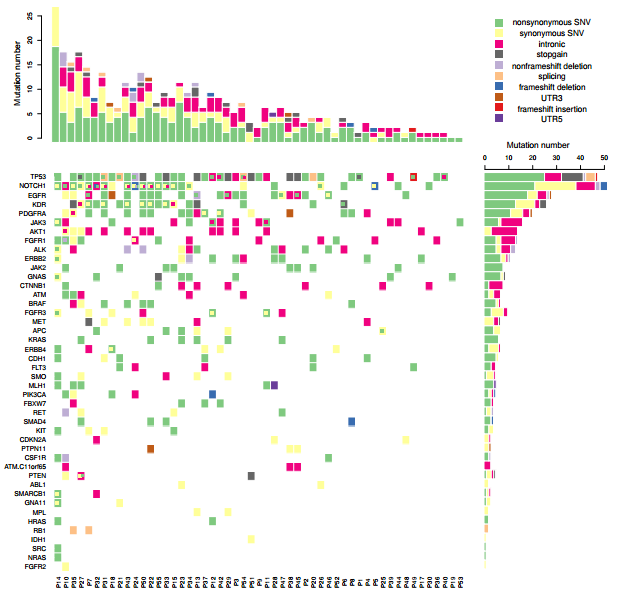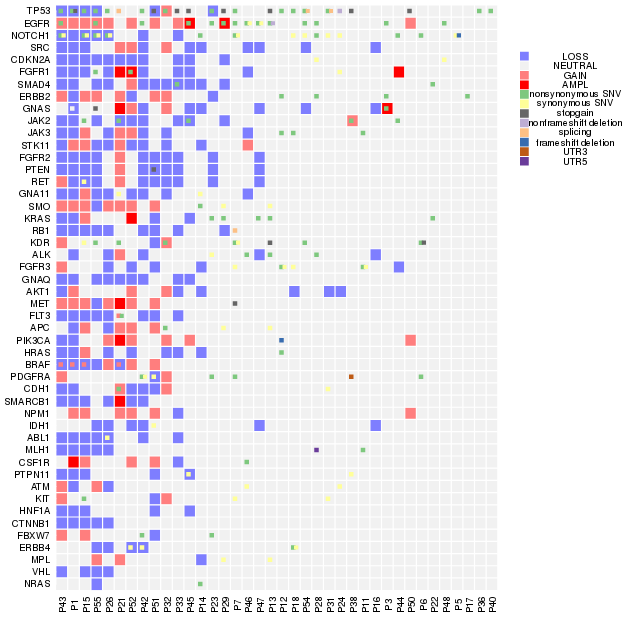

我们平常多见的基因突变热图是一个基因一个格子,一种突变类型,但实际上在同一个病人中,同一个基因往往具有多种突变类型,因此传统的热图绘制工具并不能满足我们绘图的需要。应研究需要,本人自己写了一个热图绘制函数,内部调用image 进行热图的绘制, barplot进行直方图绘制, 用data.table进行数据处理。对于一个基因内多种突变类型如何表现出来的问题, 这个函数先采用image将初步的热图绘制出来,再使用points,以方块形式将第二种突变,第三种突变依次添加, 在添加的同时方块位置稍为移动并且伴随着大小的略微缩小,以实现更好的显示效果,最多能在一个热图格子上表示四种突变。
函数如下, 需要安装并加载data.table 1.10.4, 加载RColorBrewer
my_heatmap <- function(vr, pal = c("#F2F2F2",colorRampPalette(c("blue", "white", "red"))(5)[c(1,2)],"#F2F2F2",colorRampPalette(c("blue", "white", "red"))(5)[c(4,5)],brewer.pal(n = 8, name ="Accent")[c(1,4,6,8,2,3,5,7)],"#E31A1C","#6A3D9A"),type = c("DEL","LOSS","NEUTRAL","GAIN","AMPL","nonsynonymous SNV","synonymous SNV","intronic","stopgain","nonframeshift deletion","splicing", "frameshift deletion","UTR3","frameshift insertion","UTR5"),
order_gene = T, order_patient = T, hist_plot = T, legend_dist = 0.4, col_text_cex = 1, sub_gene= NULL,heatmap_mar = c(5,17,1,2), heatmap_oma=c(0.2,0.2,0.2,0.2),heatmap_mex=0.5, legend_mar = c(1,0,4,1),xlab_adj=1, order_omit=c("NoMut","NEUTRAL"))
{
if((length(pal) - length(type)) !=1 ){stop("Pal must be one longer than type, because first one pal is col for no mutation")}
if(!is.null(sub_gene)){
pal_dt <- data.table(pal, type=c("NoMut",type))
vr <- vr[Gene %in% sub_gene,]
type <- pal_dt[type %in% unique(vr$Type),type]
pal <- c(pal[1],pal_dt[type, on="type"][,pal])
}else{
pal_dt <- data.table(pal, type=c("NoMut",type))
type <- pal_dt[type %in% unique(vr$Type),type]
pal <- c(pal[1],pal_dt[type, on="type"][,pal])
}
dt <- unique(vr[,.(Gene,Type,Patient)])
if(is.null(type)){type <- data.table(table(vr$Type))[order(-N),V1]}
dt$Type <- factor(dt$Type, levels = type)
gene <- dt[!Type %in% order_omit,.(N=length(unique(Patient))),by=Gene][order(N),Gene]
dt$Gene <- factor(dt$Gene, levels = gene)
patient <- data.table(table(vr[!Type %in% order_omit,]$Patient))[order(-N),V1]
dt$Patient <- factor(dt$Patient, levels = c(patient, setdiff(unique(dt$Patient),patient)))
if(order_gene & !order_patient){setkey(dt, "Gene")}
if(!order_gene & order_patient){setkey(dt, "Patient")}
if(order_gene & order_patient){setkey(dt, "Gene","Patient","Type")}
n <- length(unique(dt$Type))
dt$Gene_Patients <- paste(dt$Gene, dt$Patient)
dt_inf <- dt[,.N,by=.(Gene, Patient)]
max_mut_num <- max(dt_inf$N)
dt[,Mut_num:=seq_len(.N),by=.(Patient,Gene)]
#main plot, heatmap using first mutation type
dt1 <- copy(dt)
dt1[Mut_num !=1, Type:=NA]
dc <- data.frame(dcast(dt1, Patient ~ Gene, value.var = "Type", fun.aggregate = function(x)(x[!is.na(x)][1])))
rownames(dc)<- dc[,1]
data_matrix<-data.matrix(dc[,-1])
data_matrix[is.na(data_matrix)] <- 0
pal=pal
breaks<-seq(-1,10,1)
if(!hist_plot){
layout(matrix(data=c(1,2), nrow=1, ncol=2), widths=c(8,2), heights=c(1,1))
par(mar=heatmap_mar, oma=heatmap_oma, mex=heatmap_mex)
}else if(hist_plot){
layout(matrix(c(2,4,1,3),2,2,byrow=TRUE), widths=c(3,1),
heights=c(1,3), TRUE)
par(mar=heatmap_mar)
}
image(x=1:nrow(data_matrix),y=1:ncol(data_matrix),
z=data_matrix,xlab="",ylab="",breaks=breaks,
col=pal[1:11],axes=FALSE)
#sub plot, points using other mutation type
add_plot <- function(dt, i){
dt1 <- copy(dt)
dt1[Mut_num != i, Type:=NA]
dc <- data.frame(dcast(dt1, Patient ~ Gene, value.var = "Type", fun.aggregate = function(x){ifelse(length(x) >1,x[!is.na(x)][1],factor(NA))}))
rownames(dc)<- dc[,1]
data_matrix <- data.matrix(dc[,-1])
xy <- which(data_matrix !=0, arr.ind = T)
#apply(xy, 1, function(x)points(x[1], x[2],pch=15, cex=2.5 -0.5*i, col=pal[data_matrix[x[1],x[2]]+1]))
apply(xy, 1, function(x)points(x[1]-0.6+i*0.25, x[2],pch=15, cex=1.2 - i*0.08, col=pal[data_matrix[x[1],x[2]]+1]))
}
ploti <- data.frame(i=2:max_mut_num)
apply(ploti, 1, function(i){print(add_plot(dt, i))})
text(x=1:nrow(data_matrix)+0.1, y=par("usr")[1] - xlab_adj,
srt = 90, adj = 0.5, labels = rownames(data_matrix),
xpd = TRUE, cex=col_text_cex)
axis(2,at=1:ncol(data_matrix),labels=colnames(data_matrix),
col="white",las=1, cex.lab=0.1)
abline(h=c(1:ncol(data_matrix))+0.5,v=c(1:nrow(data_matrix))+0.5,
col="white",lwd=2,xpd=F)
#title("Correlation between genes",line=8,adj=0)
if(hist_plot){
#bar plot
par(mar=c(0,2+0.5,3,heatmap_mar[4]-0.9))
patient_dt <- dt[,.N,by=.(Patient,Type)]
mt <- data.frame(dcast(patient_dt, Type ~ Patient, value.var = "N"))
data_matrix <- data.matrix(mt[,-1])
rownames(data_matrix) <- mt[,1]
tryCatch(data_matrix <- data_matrix[setdiff(type, order_omit), patient], error = function(e){print("type argument or your patient name format(include "-" and so on )")})
data_matrix[is.na(data_matrix)] <- 0
omit_idx <- NULL
for(i in order_omit){omit_idx <- c(omit_idx,1+which(type == i))}
barplot(data_matrix, col=pal[-c(1,omit_idx)],space=0,border = "white",axes=T,xlab="",ann=F, xaxt="n")
par(mar=c( heatmap_mar[1]-2 , 0.8, heatmap_mar[3]+2.2, 3),las=1)
gene_dt <- dt[,.N,by=.(Gene,Type)]
mt <- data.frame(dcast(gene_dt, Type ~ Gene, value.var = "N"))
data_matrix <- data.matrix(mt[,-1])
rownames(data_matrix) <- mt[,1]
gene <- gsub("ATM,", "ATM.", gene)
tryCatch(data_matrix <- data_matrix[setdiff(type, order_omit), gene], error = function(e){print("type argument or check your gene name format(please not include "-" and so on)")})
data_matrix[is.na(data_matrix)] <- 0
barplot(data_matrix, col=pal[-c(1,omit_idx)],space=0,border = "white",axes=T,xlab="", ann=F, horiz = T, yaxt="n")
}
#add legend
par(mar=legend_mar)
plot(3, 8, axes=F, ann=F, type="n")
ploti <- data.frame(i=1:length(type))
if(!hist_plot){
tmp <- apply(ploti, 1, function(i){print(points(2, 10+(length(type)-i)*legend_dist, pch=15, cex=2, col=pal[i+1]))})
tmp <- apply(ploti, 1, function(i){print(text(3, 10+(length(type)-i)*legend_dist, labels = type[i],pch=15, cex=1, col="black"))})
}
if(hist_plot){
tmp <- apply(ploti, 1, function(i){print(points(2, 5+(length(type)-i)*legend_dist, pch=15, cex=0.9, col=pal[i+1]))})
tmp <- apply(ploti, 1, function(i){print(text(2.8, 5+(length(type)-i)*legend_dist, labels = type[i],pch=15, cex=0.9, col="black"))})
}
}
描述:
绘制一个基因可以同时显示多种突变类型的热图,输入三列的data table数据框, 列名分别是Gene,Type, 和 Patient,输出热图, 还可以在热图上方和右方添加突变的直方图。
用法:
my_heatmap(vr, pal = c("#F2F2F2",colorRampPalette(c("blue", "white", "red"))(5)[c(1,2)],"#F2F2F2",colorRampPalette(c("blue", "white", "red"))(5)[c(4,5)],brewer.pal(n = 8, name ="Accent")[c(1,4,6,8,2,3,5,7)],"#E31A1C","#6A3D9A"),type = c("DEL","LOSS","NEUTRAL","GAIN","AMPL","nonsynonymous SNV","synonymous SNV","intronic","stopgain","nonframeshift deletion","splicing", "frameshift deletion","UTR3","frameshift insertion","UTR5"),order_gene = T, order_patient = T, hist_plot = T, legend_dist = 0.4, col_text_cex = 1,xlab_adj=1, sub_gene= NULL,heatmap_mar = c(5,17,1,2), heatmap_oma=c(0.2,0.2,0.2,0.2),heatmap_mex=0.5, legend_mar = c(1,0,4,1), order_omit=c("NEUTRAL"))参数:
vr: 含有变异数据的数据框,共三列,列名分别是Gene, Type, Patient;
pal: 色板,向量,需要根据数据框中突变类型的数量进行自定义,需要比突变类型多一种颜色作为背景色,背景色放在第一位;
type:色板相对应的突变类型,向量,type必须等于或者多于数据中所出现的所有类型;默认使用拷贝数的四种突变类型加上拷贝数中性再加上annovar中所有突变类型;自定义设置时长度要比色板少1;
order_gene: 默认T, 对基因按照突变的病人数目进行排序;
order_patient:默认T,对病人按照突变的基因数目进行排序;
hist_plot:默认T,在上方和右方加上对应的直方图;
legend_dist:默认0.4,调整图例之间相互的距离,一般需要自行调整;
col_text_cex:调整病人名称的大小,默认1;
xlab_adj:调整病人名称与热图之间的距离;
sub_gene:只选择部分基因进行画图,需要给基因名的向量,并且基因需要在数据中存在,默认NULL
heatmap_mar:mar参数,调整热图前后左右的边缘长度,默认c(5,17,1,2)
heatmap_oma:oma参数,调整热图前后左右的外边缘长度,默认c(0.2,0.2,0.2,0.2)
mex:调整热图的mex参数,用于描绘绘图边缘的坐标,默认0.5
legend_mar:legend的mar参数,调整图例的位置,默认c(1,0,4,1)
order_omit:排序时忽略的变异类型,这些突变类型在直方图中也会被过滤,默认c("NEUTRAL"),如果不存在"NEUTRAL"这种突变类型,也可以保持默认参数。
细节:
- 运行前需要加载data.table1.10.4, RColorBrewer;
- 如果要绘制带有直方图的热图,因为图片尺寸过大,因此要使用pdf函数并要给足够大的宽度和长度;
- 默认使用的是annovar注释的突变类型;
- 因为绘制时影响热图和直方图对齐的因素太多,很难通过调节相应的mar,mex,oma参数达到较好的效果,因此推荐快速画出个大概后,再使用inkscape或adobe进行排版对齐
- 如果热图中突变类型的点过小,可以减小pdf文件的宽度和长度。
使用例子:
#without hist plot
pdf("~/project/PE/fromws02/PE/cnv_plot/heatmap_cnv_mut.pdf", height=12, width = 12)
my_heatmap(vr, heatmap_mar = c(17,17,1,2),hist_plot = F, legend_dist=0.1, xlab_adj = 1.2, order_patient = T, order_gene = T)
dev.off()
#with hist plot
pdf("~/project/PE/fromws02/PE/cnv_plot/heatmap_hist_cnv_mut.pdf", height=12, width = 12)
my_heatmap(vr, heatmap_mar = c(17,7,1,2),hist_plot = T, legend_dist=0.3, xlab_adj = 1.2, order_patient = T, order_gene = T)
dev.off()
#only a few gene
pdf("~/project/PE/fromws02/PE/cnv_plot/Assoc_CN1.pdf", height=2,width = 14)
my_heatmap(vr, heatmap_mar = c(7,17,1,2), sub_gene = c("CDKN2A", "GNAQ", "NOTCH1", "RB1", "SMAD4", "ABL1"),hist_plot = F,legend_dist=0.2, xlab_adj = 0.9, order_omit = "NEUTRAL")
dev.off()